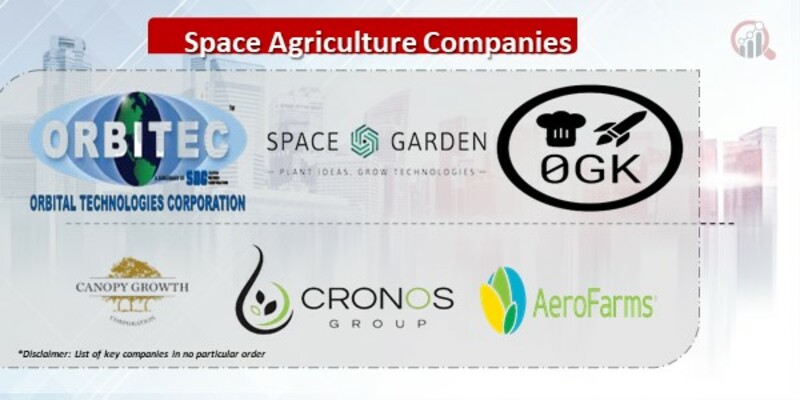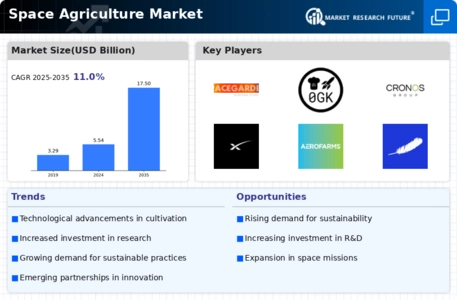Top Industry Leaders in the Space Agriculture Market
Global Space Agriculture Market Outlook

The Space Agriculture Market has witnessed unprecedented growth in recent years, fueled by the intersection of technological advancements, growing population, and the need for sustainable food production. This dynamic industry has attracted a diverse range of players, each vying for a significant share in the burgeoning market. The competitive landscape of Space Agriculture is shaped by a myriad of factors, including innovative technologies, strategic partnerships, and a relentless pursuit of efficiency and sustainability.
Key Players and Market Dynamics:
-
Orbital Technologies Corporation
-
Space Garden
-
Zero-G Kitchen
-
Canopy Growth Corporation
-
Cronos Group
-
SpaceX
-
AeroFarms
-
Blue Origin
-
Aeroponics International
-
Space Tango
Strategies Adopted: The strategies adopted by key players in the Space Agriculture market are diverse and reflective of the multifaceted nature of the industry. Vertical integration, wherein companies control multiple stages of the supply chain, is a common strategy. SpaceX, for instance, integrates its space transportation capabilities with agricultural technologies, offering end-to-end solutions for extraterrestrial farming. Collaborations and partnerships are also prevalent, as companies seek to combine their strengths in technology, agriculture, and space exploration to overcome complex challenges.
Factors for Market Share Analysis: Market share analysis in the Space Agriculture sector is influenced by various factors, reflecting the industry's unique challenges and opportunities. Technological innovation plays a pivotal role, with companies investing heavily in research and development to create cutting-edge solutions. Resource efficiency and sustainability are key determinants of market share, as consumers and investors increasingly prioritize environmentally friendly practices. Accessibility to space and the ability to overcome logistical challenges further differentiate market leaders from their competitors.
New and Emerging Companies: In addition to established players, a wave of new and emerging companies has entered the Space Agriculture market, contributing to its dynamism. Startups like Astrosat, ExoFarms, and Stellar Harvest have brought fresh perspectives and innovative solutions. Astrosat, for example, focuses on developing satellite-based technologies to monitor and optimize agricultural processes in space. The influx of these startups indicates a growing interest in the sector, driven by the potential for groundbreaking advancements and economic opportunities.
Industry News and Current Trends: Keeping abreast of industry news and current trends is crucial in understanding the evolving landscape of Space Agriculture. Recent developments include breakthroughs in controlled environment agriculture (CEA) techniques, advancements in hydroponics and aeroponics, and the integration of artificial intelligence for precision farming in space. These trends underscore the industry's commitment to overcoming challenges related to resource scarcity, microgravity, and harsh extraterrestrial environments.
Company Investment Trends: Investment trends in the Space Agriculture market reflect the confidence of stakeholders in the sector's future potential. Funding rounds for companies specializing in space-based agriculture have seen a significant uptick, with venture capital firms, government agencies, and private investors showing heightened interest. Notable investments include SpaceX's infusion of capital into its agricultural division, signaling a strategic commitment to the convergence of space technology and agriculture. These trends indicate a positive outlook for the industry and underscore the importance of continued investment in research and development.
Overall Competitive Scenario: The competitive scenario in the Space Agriculture market is characterized by a delicate balance between collaboration and competition. While companies often form strategic partnerships to leverage complementary strengths, they also compete fiercely for market share and technological dominance. The convergence of traditional agriculture with space technology necessitates a multidisciplinary approach, with companies competing not only in the development of space-ready crops but also in the optimization of cultivation techniques, water and nutrient management, and the creation of sustainable closed-loop systems.
As the Space Agriculture market continues to evolve, the competitive landscape is set to become even more intricate. Key players will strive to differentiate themselves through technological innovation, sustainable practices, and strategic collaborations. The entry of new and emerging companies brings fresh perspectives and ideas, further enriching the industry. Monitoring investment trends and staying abreast of industry news will be crucial for stakeholders seeking to navigate the challenges and capitalize on the opportunities presented by this frontier market. The Space Agriculture sector, at the intersection of space exploration and agriculture, holds the promise of not only feeding future generations on Earth but also sustaining human life beyond our planet.
Recent News :
-
Orbital Technologies Corporation (OTC):
Successfully completed a trial growing lettuce and herbs in its Veggie greenhouse aboard the International Space Station (ISS), demonstrating practical food production potential.
Secured a multi-million dollar contract with NASA to develop a larger-scale space agriculture system for future deep-space missions.
-
Space Garden:
Partnered with a leading university to research vertical farming technologies tailored for microgravity environments, pushing the boundaries of efficiency and space utilization.
Unveiled a prototype of a modular and transportable space agriculture unit, aiming to provide adaptable solutions for various celestial outposts.
-
Zero G Kitchen:
Gained traction with its culinary experiments using space-grown produce, showcasing the possibilities of diverse and flavorful diets in space.
Collaborated with a food technology company to develop edible insects as a sustainable protein source for future space missions.
-
AeroFarms (AFV):
Leverage their extensive expertise in vertical farming to develop specialized systems for lunar and Martian environments, considering unique atmospheric and gravitational challenges.
Partnered with space agencies to explore the potential of utilizing existing lunar materials, like regolith, as fertilizers for space agriculture.

